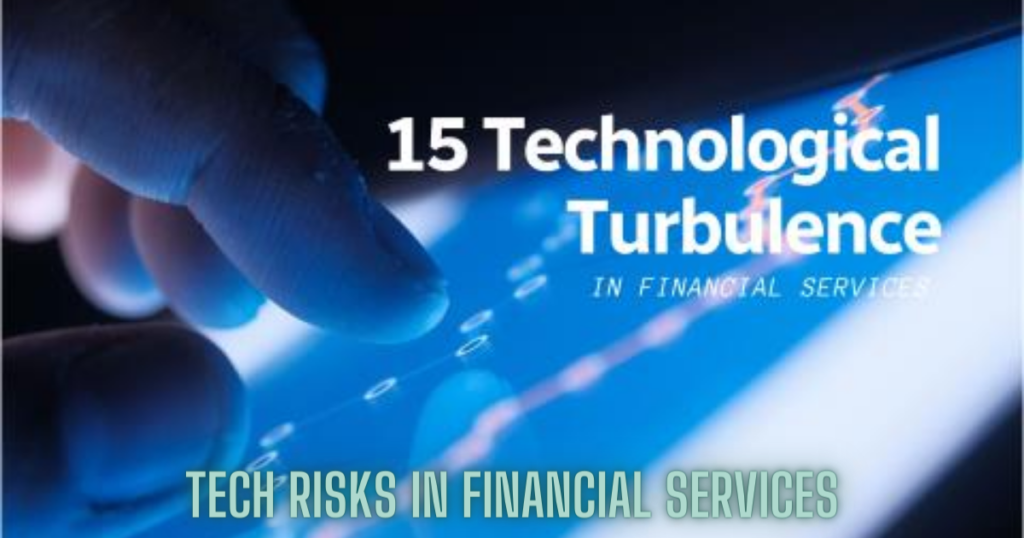Introduction
The financial services sector is continually evolving, driven by technological advancements. From artificial intelligence to decentralized finance, these disruptions are reshaping how we manage money, invest, and transact. In this article, we explore 15 Tech Risks In Financial Services that are propelling the industry forward.

15 Tech Risks In Financial Services
The followings are the 15 important Tech Risks In Financial Services that are propelling the industry forward.
1. Generative AI: The Rise of Intelligent Automation
Generative Artificial Intelligence (AI) is no longer science fiction—it’s a reality. Financial institutions leverage AI algorithms for algorithmic trading, risk assessment, and personalized customer experiences. Chatbots handle routine inquiries, robo-advisors optimize portfolios, and fraud detection systems safeguard transactions. As AI matures, its impact on efficiency, accuracy, and decision-making will only intensify.
2. Cloud Migration: From On-Premises to the Sky
The cloud is no longer a buzzword; it’s a strategic imperative. Financial institutions are migrating from traditional on-premises infrastructure to cloud-based solutions. Scalability, cost-effectiveness, and agility drive this shift. However, security and regulatory compliance remain paramount. As data moves to the cloud, institutions must strike a delicate balance between innovation and risk management.
3. Embedded Finance: Blurring Industry Boundaries
Embedded finance smoothly blends financial services into non-financial platforms. Imagine buying insurance while booking a flight or managing investments within a retail app. APIs enable this convergence, creating new revenue streams and enhancing customer experiences. As boundaries blur, financial institutions must adapt to this interconnected ecosystem.
4. Cybersecurity Challenges: The Battle Against Threats
The digital landscape exposes financial institutions to cyber threats. Ransomware attacks, data breaches, and identity theft loom large. Robust cybersecurity measures are non-negotiable. Encryption, threat intelligence, and employee training are essential. Institutions must stay ahead of adversaries to protect sensitive data and maintain trust.
5. Decentralized Finance (DeFi): Disrupting Traditional Models
DeFi leverages blockchain technology to create decentralized financial ecosystems. Smart contracts automate transactions, decentralized exchanges eliminate intermediaries, and lending protocols redefine borrowing. While DeFi promises transparency and accessibility, regulatory clarity and scalability remain challenges. The industry grapples with balancing innovation and compliance.
6. Quantum Computing: Unlocking Unprecedented Power
Quantum computing holds immense promise for finance. It can revolutionize risk modeling, portfolio optimization, and cryptography. However, practical adoption is nascent, and challenges like error correction persist. As quantum leaps occur, financial institutions must prepare for a paradigm shift.
7. Open Banking: Empowering Consumers-Tech Risks In Financial Services
Open banking mandates secure sharing of customer data with third-party providers. APIs facilitate seamless access to financial services, enabling personalized offerings and fostering competition. Data governance and privacy concerns are focal points. Institutions that embrace open banking can enhance customer experiences and drive innovation.
8. RegTech: Navigating Regulatory Complexity
Regulatory Technology (RegTech) streamlines compliance processes. Machine learning, natural language processing, and predictive analytics help institutions stay compliant while minimizing costs. Regulators benefit from real-time insights, and institutions gain agility in an ever-evolving regulatory landscape.
9. Biometric Authentication: Beyond Passwords-Tech Risks In Financial Services
Biometrics—fingerprint scans, facial recognition, and voice authentication—are replacing traditional passwords. Enhanced security and user experience reduce fraud and build trust. Financial institutions must adopt biometric solutions while addressing privacy concerns.
10. Blockchain and Digital Assets: Transforming Transactions
Blockchain ensures secure, transparent, and tamper-proof transactions. Beyond cryptocurrencies, it enables tokenization of assets, smart contracts, and supply chain traceability. Financial institutions exploring blockchain must navigate regulatory nuances and scalability challenges.
11. Robotic Process Automation (RPA): Streamlining Operations-Tech Risks In Financial Services
RPA automates repetitive tasks, reducing errors and operational costs. Back-office processes, customer onboarding, and reconciliation benefit from RPA. As institutions embrace automation, employees can focus on value-added activities.
12. Insurtech Innovations: Personalized Policies
Insurtech disrupts insurance by leveraging data analytics, IoT (Internet of Things), and telematics. Customized policies, usage-based premiums, and claims automation redefine the industry. Insurers must adapt to changing customer expectations and embrace digital transformation.
13. Digital Wallets and Payments: Cashless Convenience
Mobile wallets, contactless payments, and peer-to-peer transfers redefine how we transact. Cryptocurrencies and stablecoins add further complexity to the payments landscape. Financial institutions must provide seamless, secure payment options to meet customer demands.

14. Data Analytics: Extracting Insights-Tech Risks In Financial Services
In the era of big data, financial institutions swim in an ocean of information. Data analytics is the ring leading strategic decisions:
- Predictive Models: The Machine learning algorithms scan historical data to predict future trends. From credit risk assessment to stock market forecasts, predictive models enhance accuracy.
- Sentiment Analysis: Natural language processing (NLP) deciphers sentiments from social media posts, news articles, and customer reviews. Understanding public sentiment helps institutions adapt swiftly.
- Customer Segmentation: Data-driven segmentation allows personalized marketing. Tailoring products and services to specific customer groups improves engagement and loyalty.
- Fraud Detection: Anomaly detection algorithms sift through transaction data to identify suspicious patterns. Real-time fraud alerts protect both customers and institutions.
15. Environmental, Social, and Governance (ESG) Tech: Responsible Finance-Tech Risks In Financial Services
ESG factors are no longer optional—these are integral to investment decisions. Technology plays a crucial role in assessing and promoting responsible finance:
- ESG Reporting: Technology streamlines the collection, analysis, and reporting of ESG data. Real-time dashboards provide insights into an organization’s environmental impact, social initiatives, and governance practices.
- Impact Measurement: AI and data analytics quantify the impact of investments on ESG criteria. Investors can assess not only financial returns but also their contribution to sustainability goals.
- Sustainable Investing Platforms: Fintech startups are creating platforms that connect investors with ESG-focused opportunities. These platforms curate portfolios aligned with specific ESG themes, such as clean energy, gender equality, or ethical supply chains.
- Blockchain for Transparency: Blockchain ensures transparency in supply chains, verifying sustainable practices. From tracking the origin of conflict-free minerals to verifying fair trade certifications, blockchain enhances trust.
- Climate Risk Assessment: Machine learning models analyze climate-related risks. Financial institutions evaluate their exposure to physical risks (e.g., extreme weather events) and transition risks (e.g., policy changes or technological shifts).
Conclusion-Tech Risks In Financial Services
The financial services industry stands at the intersection of tradition and transformation. As these 15 technological turbulences converge, institutions must adapt swiftly. Collaboration, innovation, and ethical considerations will define success. Whether it’s embracing AI, securing the cloud, or championing ESG principles, financial leaders must navigate these winds of change with resilience and foresight.
Remember, the future of finance isn’t just about numbers—it’s about impact. Let’s harness technology to create a more sustainable, inclusive, and resilient financial ecosystem.
FAQs and Answer
What are the 5 risks of technology?
Cybersecurity Risks: Including data breaches, hacking, and malware attacks.
Privacy Risks: Concerns over the unauthorized use or disclosure of personal information.
Operational Risks: Such as system failures, technical glitches, and downtime.
Regulatory Risks: Compliance with laws and regulations governing technology use.
Technological Obsolescence: The risk of investments becoming outdated or obsolete due to rapid technological advancements.
What are the 7 financial risks?
Market Risk: The risk of losses due to fluctuations in market prices or interest rates.
Credit Risk: The risk of loss arising from the failure of a borrower to repay a loan or meet financial obligations.
Liquidity Risk: The risk of not being able to sell assets quickly enough to meet financial obligations.
Operational Risk: Risks related to internal processes, systems, and human error.
Legal and Regulatory Risk: Risks arising from non-compliance with laws and regulations.
Reputational Risk: The risk of damage to a company’s reputation due to negative publicity or events.
Strategic Risk: Risks associated with strategic decisions, market positioning, and business model changes.
What are the types of risk in financial services? (प्रौद्योगिकी के 5 जोखिम क्या हैं?)
Credit Risk: The risk of loss due to a borrower’s inability to repay a loan.
Market Risk: Risks associated with fluctuations in market prices or interest rates.
Operational Risk: Risks arising from internal processes, systems, and human error.
Liquidity Risk: The risk of not being able to meet financial obligations due to a lack of liquidity.
Regulatory Risk: Risks related to non-compliance with laws and regulations governing financial services.
Disclaimer
This article relies on internal data, publicly available information, and other reliable sources. It may also include the authors’ personal views. However, it’s essential to note that the information is for general, educational, and awareness purposes only—it doesn’t disclose every material fact. This analysis is for informational purposes only and does not constitute financial advice. Consult a professional before making investment decisions.
We publish information on World Virtual CFO in good faith, solely for general information. World Virtual CFO doesn’t guarantee the completeness, reliability, or accuracy of this information. These are our views for informational purposes. When you use our website, know that any action you take is entirely at your own risk. World Virtual CFO won’t be liable for any losses or damages connected to your use of our website. For detailed information, refer to our disclaimer page.
Dr. Dinesh Sharma is an award-winning CFO and AI strategist with over two decades of experience in financial leadership, digital transformation, and business optimization. As the founder of multiple niche platforms—including WorldVirtualCFO.com—he empowers professionals and organizations with strategic insights, system structuring, and innovative tools for sustainable growth. His blogs and e-books blend precision with vision, making complex financial and technological concepts accessible and actionable.